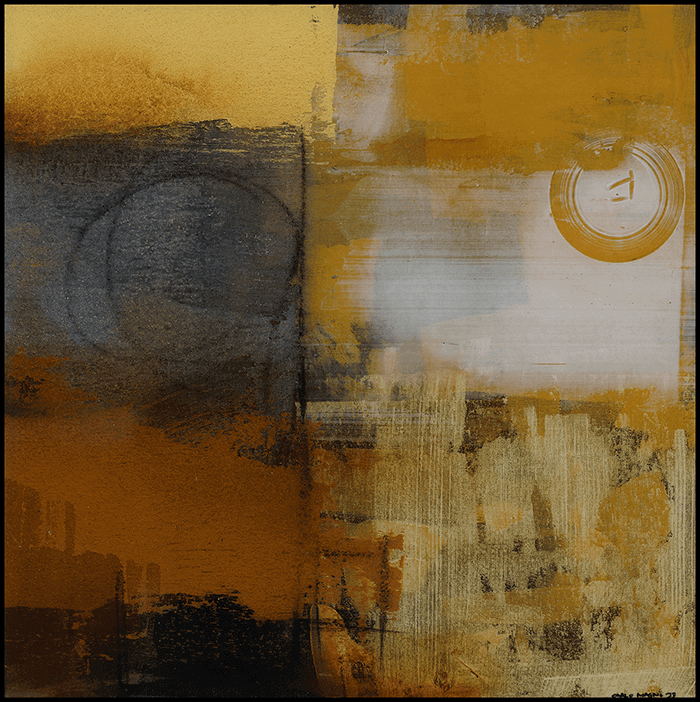Into the macro with artist Carlo Magno
Not every artist gets to shift gears midway through life’s journey, but Carlo Magno did. His show “Percipience,” which closes today at Galerie Joaquin BGC, marks 40 years as an artist, half of those years devoted to hyperrealist canvases detailing houses and churches in Vigan and elsewhere—vivid red and blue doors and exteriors, highly textured, ravaged by time and the elements. There’s a beauty in erosion—a “tingling,” Carlo calls it—that is expressed in these realist works from the ‘70s through the ‘90s. (Magno is also known for painting the famed “Love Bus” from that earlier decade, an icon of Filipino art and pop culture.)
Then he decided to shift. The next two decades were a deep dive into abstraction—a risky move, but for him, necessary. “I got really drained,” he says of his realist phase. “I felt like I was in a box. I couldn't move or explore or experiment. It felt like I wanted to explode, something like that.”
It took “maybe two to four years” to explore a new style. “So I did what I really wanted—some kind of gestural, minimalist works, because it felt good.”

Magno’s recent large abstractions in “Percipience” (the title refers to a new kind of perspective) are laden with natural elements—over the compositional form of each piece, done in rich ochres, deep-sea blues, and De Kooning-like bursts of red, there are traces of glued sand (“I used to get from Boracay in those little bottles”), talismanic circles etched strategically into the composition (“It's like an entity. Everything else revolves around it”), and he uses a charcoal stick, straight from the grill, to overlay markings that may or may not suggest figures running, dancing. He cites “the gestures of (Pittsburgh artist Samuel) Rosenberg” as an influence.
The idea in “Percipience” is that Magno is viewing his “memories” of those Vigan walls and houses from a new perspective. “The brushstrokes are still there. It’s still me. Actually, the facades of the old houses and churches, they’re still there. It’s just like taking a picture in macro view.”

It takes a kind of seeing, this macro view. A kind of processing of memory. There’s that William Carlos William poem: “So much depends on a red wheel barrow glazed with rain water beside the white chickens.” Magno’s red and blue barn doors are almost iconic, in their earlier hyperrealist renditions. Memory has changed their context, but the gestures, the strokes remain the same.
I ask how texture—and its erosive forms—is related to emotion and memory for him. “I feel it’s about the time element (which is also the title of one of his works). It’s about how the textures change over time.”

Magno also included a number of sculptures he admits are “more about the base” than the figures mounted on top: the colored resin blocks below contain swirling ripples of aqua-blue; above is planted a swimming figure, or a Buddha-like version of Leonardo’s “Vitruvian Man.” The cast aluminum figures are a kind of lighthearted counterpoint. “The figures are just incidentals, something humorous,” he says. “The actual base is quiet; so serious.”
Magno is extremely meticulous when picking up a new medium. At lunch along with his wife Susanne Tiausas, managing director of Art Lounge Manila, the artist tells us about an early attempt at bronze sculpture that left him cold. “My friends said it was so beautiful, they lied to me. Pangit!”

“He wasn’t happy with it,” Susanne adds, so it sat in their sala a long time. “Finally he said, ‘Okay, anybody who can carry that with one hand can take it home.” A Thor’s Hammer challenge from the artist.
Slipping into “macro focus” is something Magno has always done. He learns some new skill or medium extensively over time, over years— whether it’s CAD computer designing, bronze or silver casting, even HAM radio skills—then moves onto the next challenge.

Since he seems to work in 20-year cycles, I ask Carlo what the next shift will be. He doesn’t know, but he has more interaction with technology now: his sculpture casts are often 3D-printed. And he’s aware of AI art, NTFs and all the new-fangled angles.
Carlo Magno’s work, in both realist and abstract forms, has been a steady influence on younger artists. One can see detailed examinations of weather-beaten doors and houses from many other artists—an homage either to the artist’s vision or the idea itself of macro-focusing on textures, the passage of time.
Yes, you could easily feed a prompt into an AI generator and ask it to come up with a “Carlo Magno red barn door in Vigan.” But to ask AI to do a knockoff, Carlo warns, would “lessen the aesthetics.”
For one thing, it wouldn’t have a soul. It’s the one skill that AI may never acquire, no matter how extensive or meticulous its methods. “You have to have the foundations, the drawing skills, and the eye of an artist to do good art,” Carlo concludes. “It comes from the soul, and AI doesn’t have that.”
Well, for now, we add after a pregnant pause.
* * *
Carlo Magno’s “Percipience” finishes today, May 13, at Galerie Joaquin BGC, located on the Upper Ground Floor of One Bonifacio High Street Mall, 5th Ave. Corner 28th Street, Bonifacio Global City, Taguig. Contact +63 915 739 1549 or email galeriejoaquinbgc@gmail.com.



